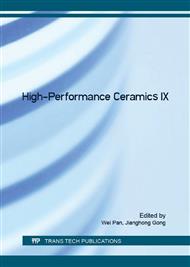p.814
p.818
p.822
p.826
p.831
p.835
p.841
p.846
p.852
Preparation and Performance of Fully Ceramic Fuel Element Using Silicon Carbide as Coating Layers
Abstract:
Tristructural-isotropic (TRISO) coated fuel particles with spherical ceramic fuel kernels followed by three layers of pyrolytic carbon and one layer of silicon carbide (SiC) is successfully used in high temperature gas cooled reactor (HTGR) system. In this paper, an improved design concept of fully ceramic fuel is proposed. The kernels were coated by SiC layers with different densities. Two kinds of SiC coatings, namely porous SiC and dense SiC were prepared by a fluidized bed chemical vapor deposition method. The densities of porous SiC and dense SiC were 1.40 g/cm3 and 3.20 g/cm3, respectively. By controlling experimental parameters, densities of the SiC layer can be adjusted. The structure and micromorphology of the coated particles were investigated by various technologies such as XRD, SEM, and EDX. The coated particles were dispersed in SiC matrix and further sintered to dense compacts. High temperature oxidation test confirmed the robustness of the fuel elements.
Info:
Periodical:
Pages:
835-840
Citation:
Online since:
July 2016
Authors:
Price:
Сopyright:
© 2016 Trans Tech Publications Ltd. All Rights Reserved
Share:
Citation:


